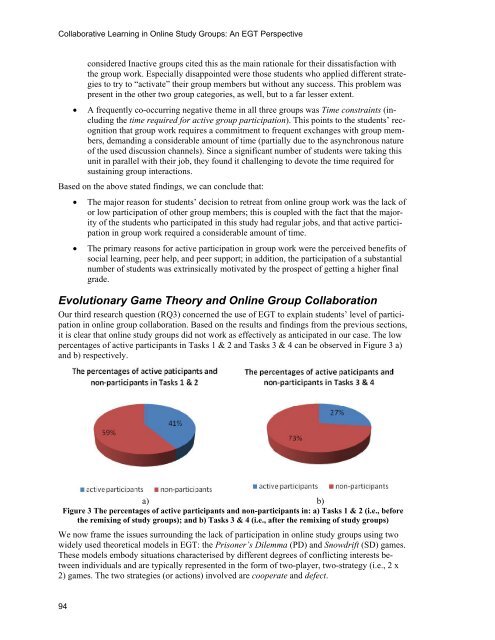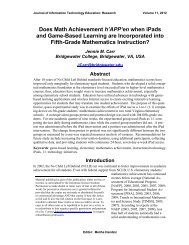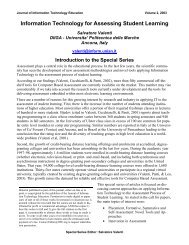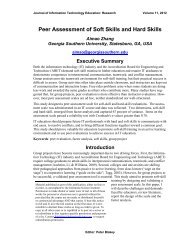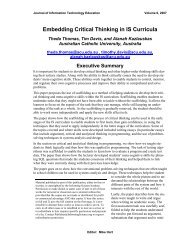Collaborative Learning in Online Study Groups - Journal of ...
Collaborative Learning in Online Study Groups - Journal of ...
Collaborative Learning in Online Study Groups - Journal of ...
You also want an ePaper? Increase the reach of your titles
YUMPU automatically turns print PDFs into web optimized ePapers that Google loves.
<strong>Collaborative</strong> <strong>Learn<strong>in</strong>g</strong> <strong>in</strong> Onl<strong>in</strong>e <strong>Study</strong> <strong>Groups</strong>: An EGT Perspective<br />
<br />
considered Inactive groups cited this as the ma<strong>in</strong> rationale for their dissatisfaction with<br />
the group work. Especially disappo<strong>in</strong>ted were those students who applied different strategies<br />
to try to “activate” their group members but without any success. This problem was<br />
present <strong>in</strong> the other two group categories, as well, but to a far lesser extent.<br />
A frequently co-occurr<strong>in</strong>g negative theme <strong>in</strong> all three groups was Time constra<strong>in</strong>ts (<strong>in</strong>clud<strong>in</strong>g<br />
the time required for active group participation). This po<strong>in</strong>ts to the students’ recognition<br />
that group work requires a commitment to frequent exchanges with group members,<br />
demand<strong>in</strong>g a considerable amount <strong>of</strong> time (partially due to the asynchronous nature<br />
<strong>of</strong> the used discussion channels). S<strong>in</strong>ce a significant number <strong>of</strong> students were tak<strong>in</strong>g this<br />
unit <strong>in</strong> parallel with their job, they found it challeng<strong>in</strong>g to devote the time required for<br />
susta<strong>in</strong><strong>in</strong>g group <strong>in</strong>teractions.<br />
Based on the above stated f<strong>in</strong>d<strong>in</strong>gs, we can conclude that:<br />
<br />
<br />
The major reason for students’ decision to retreat from onl<strong>in</strong>e group work was the lack <strong>of</strong><br />
or low participation <strong>of</strong> other group members; this is coupled with the fact that the majority<br />
<strong>of</strong> the students who participated <strong>in</strong> this study had regular jobs, and that active participation<br />
<strong>in</strong> group work required a considerable amount <strong>of</strong> time.<br />
The primary reasons for active participation <strong>in</strong> group work were the perceived benefits <strong>of</strong><br />
social learn<strong>in</strong>g, peer help, and peer support; <strong>in</strong> addition, the participation <strong>of</strong> a substantial<br />
number <strong>of</strong> students was extr<strong>in</strong>sically motivated by the prospect <strong>of</strong> gett<strong>in</strong>g a higher f<strong>in</strong>al<br />
grade.<br />
Evolutionary Game Theory and Onl<strong>in</strong>e Group Collaboration<br />
Our third research question (RQ3) concerned the use <strong>of</strong> EGT to expla<strong>in</strong> students’ level <strong>of</strong> participation<br />
<strong>in</strong> onl<strong>in</strong>e group collaboration. Based on the results and f<strong>in</strong>d<strong>in</strong>gs from the previous sections,<br />
it is clear that onl<strong>in</strong>e study groups did not work as effectively as anticipated <strong>in</strong> our case. The low<br />
percentages <strong>of</strong> active participants <strong>in</strong> Tasks 1 & 2 and Tasks 3 & 4 can be observed <strong>in</strong> Figure 3 a)<br />
and b) respectively.<br />
a) b)<br />
Figure 3 The percentages <strong>of</strong> active participants and non-participants <strong>in</strong>: a) Tasks 1 & 2 (i.e., before<br />
the remix<strong>in</strong>g <strong>of</strong> study groups); and b) Tasks 3 & 4 (i.e., after the remix<strong>in</strong>g <strong>of</strong> study groups)<br />
We now frame the issues surround<strong>in</strong>g the lack <strong>of</strong> participation <strong>in</strong> onl<strong>in</strong>e study groups us<strong>in</strong>g two<br />
widely used theoretical models <strong>in</strong> EGT: the Prisoner’s Dilemma (PD) and Snowdrift (SD) games.<br />
These models embody situations characterised by different degrees <strong>of</strong> conflict<strong>in</strong>g <strong>in</strong>terests between<br />
<strong>in</strong>dividuals and are typically represented <strong>in</strong> the form <strong>of</strong> two-player, two-strategy (i.e., 2 x<br />
2) games. The two strategies (or actions) <strong>in</strong>volved are cooperate and defect.<br />
94


